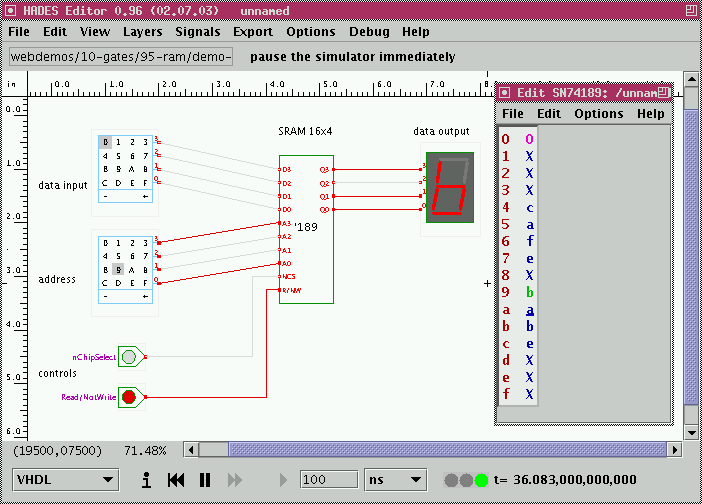

Applets
contents
visual index
 introduction
introduction std_logic_1164
std_logic_1164 gatelevel circuits
gatelevel circuits delay models
delay models flipflops
flipflops adders and arithm...
adders and arithm... counters
counters LFSR and selftest
LFSR and selftest memories
memories
 ROM circuit
ROM circuit
 1Kx8 ROM demo
1Kx8 ROM demo
 RAM structure
RAM structure
 RAM write-cycle
RAM write-cycle
 RAM read-cycle
RAM read-cycle
 RAM write-ha...
RAM write-ha...
 RAM storage ...
RAM storage ...
 RAM address ...
RAM address ...
 RAM bitline ...
RAM bitline ...
 74189 SRAM
74189 SRAM
 74219 SRAM
74219 SRAM
 74219 SRAM a...
74219 SRAM a...
 6116 CMOS SRAM
6116 CMOS SRAM
 multiple SRAMs
multiple SRAMs programmable logic
programmable logic state-machine editor
state-machine editor misc. demos
misc. demos I/O and displays
I/O and displays DCF-77 clock
DCF-77 clock relays (switch-le...
relays (switch-le... CMOS circuits (sw...
CMOS circuits (sw... RTLIB logic
RTLIB logic RTLIB registers
RTLIB registers Prima processor
Prima processor D*CORE
D*CORE MicroJava
MicroJava Pic16 cosimulation
Pic16 cosimulation Mips R3000 cosimu...
Mips R3000 cosimu... Intel MCS4 (i4004)
Intel MCS4 (i4004) image processing ...
image processing ... [Sch04] Codeumsetzer
[Sch04] Codeumsetzer [Sch04] Addierer
[Sch04] Addierer [Sch04] Flipflops
[Sch04] Flipflops [Sch04] Schaltwerke
[Sch04] Schaltwerke [Sch04] RALU, Min...
[Sch04] RALU, Min... [Fer05] State-Mac...
[Fer05] State-Mac... [Fer05] PIC16F84/...
[Fer05] PIC16F84/... [Fer05] Miscellan...
[Fer05] Miscellan... [Fer05] Femtojava
[Fer05] Femtojava FreeTTS
FreeTTS The behaviour of the 74189 circuit is controlled by just two active-low
control lines, namely the chip select and read/write
inputs:
The behaviour of the 74189 circuit is controlled by just two active-low
control lines, namely the chip select and read/write
inputs:
- nCS=1: the data outputs are tri-stated and the clock signal for the latches in the memory matrix is disabled.
- nCS=0, Read/nWrite=1: the data outputs are enabled and driven with the contents of the currently addressed memory word. When the address input is changed, the contents of the newly selected memory word will appear on the data outputs, delayed by the memory access time.
- nCS=0, Read/nWrite=0: the clock signal of the currently addressed memory latches is enabled, so that the values on the data input bus is copied into the selected memory word (transparent latches). Also, the data outputs are enabled. Switch the Read/nWrite signal back to the high (1) state to store the data.